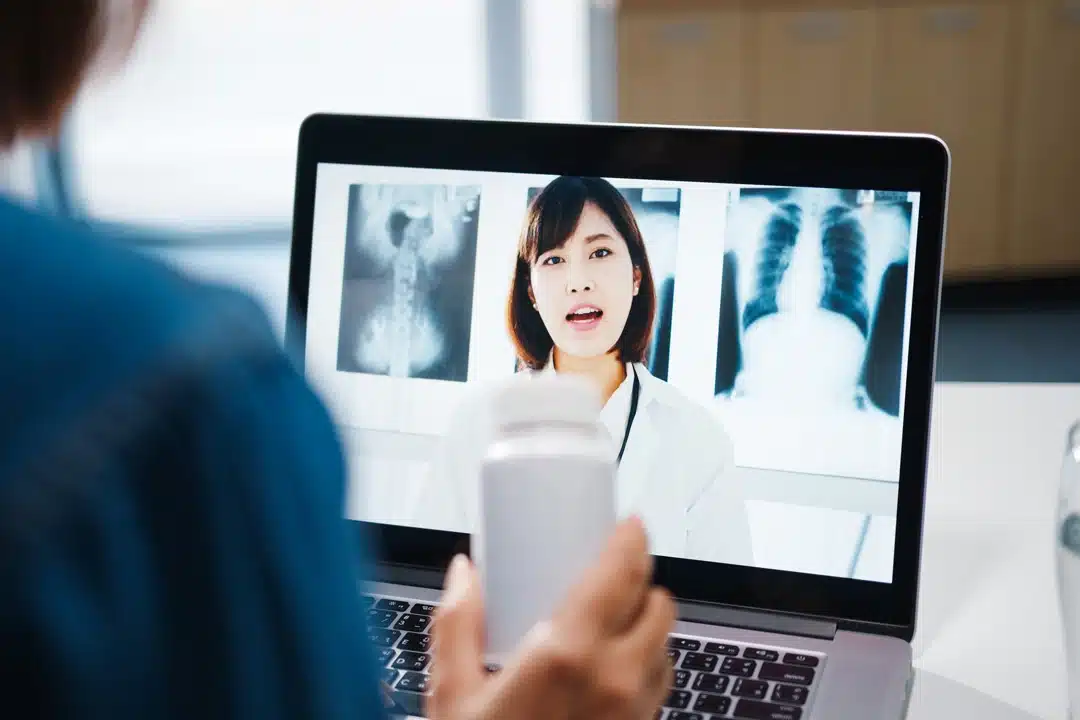Table of Contents
In the high-speed, high-tech landscape of modern healthcare, teleradiology software has swiftly carved its own niche – and in a big way too! It’s not just a passing trend or a minor player. It’s rapidly becoming a significant part of how we approach healthcare.
Just a quick glance at the numbers paints a clear picture. The global teleradiology market, estimated at $2.44 billion in 2023, is predicted to catapult to $6.28 billion by 2030. With this, it’s clear that teleradiology is playing a crucial role in enhancing healthcare delivery and improving patient outcomes.
With that being said, let’s take a look under the hood to see just what is driving (and will be driving) this exciting field to be reckoned with.
Understanding the Evolution of Teleradiology
Teleradiology has come a long way since its inception. It all began in the late 1940s, when radiographic images were sent via telephone lines between two towns in Pennsylvania. Fast forward to the 1980s, and we saw the use of early-generation computers to transmit CT scans over telephone lines. These were the first rudimentary examples of teleradiology, before the term even existed!
The advent of the revolutionized the field. This universal standard for medical images allowed for the smooth transmission of images between different systems and manufacturers. The result was a boon for teleradiology, which thrived thanks to this newfound interoperability.
The subsequent rise of high-speed internet opened the floodgates for the mass adoption of teleradiology. Rapid image transfer and immediate remote consultations became a reality, making the case for teleradiology software clear and compelling.
As teleradiology developed, it naturally found a place within the broader telemedicine ecosystem. Telemedicine, or virtual health consultations, relies heavily on the ability to share and analyze medical data remotely. Enter teleradiology, with its capacity to send radiographic images over vast distances, where virtual health consultations can now include expert radiological opinions, offering comprehensive patient care regardless of location. The integration of teleradiology into telemedicine is truly reshaping the way healthcare services are delivered, reaching people where they need it, when they need it.
Want to find out more about the world of telemedicine and telehealth software? We have some great food-for-thought articles:

What is Teleradiology Software?
Teleradiology software, at its core, is an advanced application that enables the transfer of radiological patient images, like X-rays, CTs, and MRIs, from one location to another. This software provides radiologists with the capacity to view and interpret images remotely, simplifying medical image exchange for diagnostic and consultation purposes.
How Does Teleradiology Software Work?
Teleradiology software isn’t just a single technology but rather a cohesive integration of multiple components that work together seamlessly to deliver exceptional results.
Understanding the Core Components of Teleradiology Systems

An Image Sending Station
This is where it all begins. Medical imaging devices, such as CT scanners, MRIs, or X-ray machines, generate the images. The images are then digitized and prepared for transmission. This is the role of the image-sending station. It also compresses the images to facilitate quicker transmission.

A Transmission Network
The transmission network is essentially the pathway along which the images travel from the sending station to the receiving station. This network can be a secure internet connection, a dedicated line, or even satellite-based, depending on the system’s design.

A Receiving Image Station
The receiving station is where the transmitted images are interpreted. It comprises a high-resolution monitor for viewing the images, software for enhancing the images, and tools for reporting and communication. The radiologist at the receiving station can then analyze the images and share their findings.
Image Transmission and Data Security in Teleradiology
Of course, transmitting sensitive patient data over the internet raises some eyebrows. After all, patient confidentiality and data security are paramount in healthcare. Teleradiology software addresses these concerns with encryption algorithms and secure transmission protocols that ensure the data remains inaccessible to unauthorized individuals. Data is encrypted before transmission and decrypted at the receiving end with secure keys, keeping the information under lock and key throughout the journey.
Integration with Hospital Information Systems
Teleradiology isn’t an island; it’s a connected part of a larger healthcare information system. What that means in practice is that it has to interact seamlessly with a variety of other systems.
At the heart of it all is the DICOM protocol we talked about earlier. It’s the go-between that ensures teleradiology software can communicate effectively with Hospital Information Systems (HIS), Radiology Information Systems (RIS), and Picture Archiving and Communication Systems (PACS). These systems carry a wealth of patient data, clinical history, and imaging studies, all crucial for radiologists to make accurate diagnoses. Teleradiology software fits into this jigsaw by being the channel that facilitates the transmission of images and related data from these systems to radiologists, regardless of their location.
How to Choose a Teleradiology Software Provider?
Choosing the right solution is an important decision for any healthcare facility, as this involves striking a balance between those all-important aspects, such as functionality, ease of use, integration capabilities, cost, and, of course, security. There are generally two routes one can take: an off-the-shelf solution or a custom one.
Off-the-shelf solutions are typically ready-to-use and come with a wide array of features. These can be an excellent choice for healthcare institutions looking for immediate deployment. However, they may lack the flexibility and customization options that some organizations might need.
Some popular names in pre-built systems include:
| Provider | Key Features |
| Carestream Health Inc |
|
| Cerner Corporation |
|
| RamSoft’s PowerServer™ TELE PLUS |
|
| Dicom Systems |
|
On the flip side, custom solutions offer the freedom to tailor the software to your specific needs. This can be invaluable for healthcare organizations with unique requirements or those aiming to innovate in their space. It allows for scalability and the flexibility to adapt to emerging technologies or changing regulations. It also lets you maintain control over every aspect of the software, from its features to its security measures.
Scopic, for instance, has a robust history in the medical imaging software space. With a deep understanding of the radiology software landscape, Scopic’s Teleradiology solutions are designed to empower healthcare providers to improve efficiency and deliver timely diagnoses.
Here are just a few examples of some projects we’ve worked on over the years:

Current and Future Trends in Teleradiology Software
Current Trends
Interoperability
Currently, it’s all about integration and interoperability. Modern teleradiology software is aimed at seamless integration with the existing HIS, RIS, and PACS systems. The goal? Smooth data flow for quicker, more efficient diagnoses.
Data security
Data security has also climbed up the priority ladder. As teleradiology involves the transmission of patient data over networks, ensuring a secure and HIPAA-compliant transfer is critical. Encryption technology and secure cloud storage are currently being leveraged to ensure this.
Accessibility
Accessibility has become a key cornerstone of teleradiology. Enhancing remote access to medical imaging, especially in underserved or rural areas, has been a focus. Teleradiology software is bridging this gap, ensuring that quality diagnostic care is accessible to all, irrespective of location or platform used.
Mobile-first
Then there’s the rise of mobile teleradiology. Mobile apps are extending the reach of teleradiology, offering on-the-go access to medical images and enhancing flexibility for healthcare professionals.
Future Trends
AI and Machine Learning
Looking ahead, two words come to mind: AI and Machine Learning. These technologies are expected to significantly influence teleradiology software, and for good reason. AI in radiology can automate routine tasks, assist in identifying patterns in imaging data, and potentially flag anomalies that may be overlooked by human eyes. While we’re still in the early stages, the potential is enormous.
Integration with emerging technologies
Then there’s also the integration with emerging technologies. We’re talking about technologies like Augmented Reality (AR) and Virtual Reality (VR), which could provide interactive 3D visualizations of radiological images. This can give healthcare professionals a better understanding of a patient’s condition, aiding in more accurate diagnoses and treatments.
Challenges
Of course, it’s not all smooth sailing. Along with these promising trends, there are challenges to contend with.
- The ethical implications of patient data privacy and security are ever-present. Even as software providers employ advanced security measures, data breaches remain a significant concern.
- Regulatory compliance is another complex issue. Different regions have varying regulations related to telemedicine and patient data, and navigating these can be tricky for software providers.
- And while AI and ML present exciting possibilities, they also bring their own set of challenges, including the need for vast amounts of annotated data for training, managing algorithmic bias, and ensuring the explainability of AI decisions.
That said, it’s a dynamic and exciting field, and despite these challenges, the potential of teleradiology software in enhancing healthcare delivery is immense.
Conclusion
In the grand scheme of modern healthcare, the significance of teleradiology software is undeniable, and as we forge ahead, this technology will continue to adapt, evolve, and innovate, playing a significant role in creating a more equitable healthcare future.
If you’re considering the implementation of a teleradiology system that’s tailored to your specific needs, let’s talk! Scopic is committed to creating custom solutions that fit the bill. Contact us today!

About Creating the Teleradiology Software Guide
This guide was authored by Courtney Schwikkard, and reviewed by Thanapong (Tom) Wongwatcharapaiboon, technical lead in engineering.
Scopic provides quality and informative content, powered by our deep-rooted expertise in telemedicine software development. Our team of content writers and experts have great knowledge in the latest software technologies, allowing them to break down even the most complex topics in the field. They also know how to tackle topics from a wide range of industries, capture their essence, and deliver valuable content across all digital platforms.




